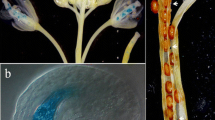Summary
5-enolpyruvylshikimate-3-phosphate synthase (EPSPs), the target of the herbicide glyphosate, catalyzes an essential step in the shikimate pathway common to aromatic amino acid biosynthesis. We have cloned an EPSP synthase gene from Arabidopsis thaliana by hybridization with a petunia cDNA probe. The Arabidopsis gene is highly homologous to the petunia gene within the mature enzyme but is only 23% homologous in the chloroplast transit peptide portion. The Arabidopsis gene contains seven introns in exactly the same positions as those in the petunia gene. The introns are, however, significantly smaller in the Arabidopsis gene. This reduction accounts for the significantly smaller size of the gene as compared to the petunia gene. We have fused the gene to the cauliflower mosaic virus 35 S promoter and reintroduced the chimeric gene into Arabidopsis. The resultant overproduction of EPSPs leads to glyphosate tolerance in transformed callus and plants.
Similar content being viewed by others
References
Ausubel F, Bahnsen K, Hanson M, Mitchell A, Smith H (1980) Cell and tissue culture of haploid and diploid petunia “Mitchell”. Plant Mol Biol News 1:26–32
Baker A, Schatz G (1987) Sequences from a prokaryotic genome or the mouse dihydrofolate reductase gene can restore the import of a truncated precursor protein into yeast mitochondria. Proc Natl Acad Sci USA 84:3117–3121
Bennett M, Smith J, Heslop-Harrison J (1982) Nuclear DNA amounts in angiosperms. Proc R Soc Lond 216:179–199
Brown I, Feix G, Frendewey D (1986) Accurate in vitro splicing of two pre-mRNA plant introns in a HeLa cell nuclear extract. EMBO J 5:2749–2758
Chang C, Meyerowitz E (1986) Molecular cloning and DNA sequence of the Arabidopsis thaliana alcohol dehydrogenase gene. Proc Natl Acad Sci USA 83:1408–1412
della-Cioppa G, Bauer C, Klein B, Shah D, Fraley R, Kishore G (1986) Translocation of the precursor of 5-enolpyruvylshikimate-3-phosphate synthase into chloroplasts of higher plants in vitro. Proc Natl Acad Sci USA 83:6873–6877
Estelle M, Somerville C (1986) The mutants of Arabidopsis. Trends Genet 2:89–93
Frischauf A-M, Lehrach H, Poustka A, Murray N (1983) Lambda replacement vectors carrying polylinker sequences. J Mol Biol 170:827–842
Gasser C, Winter J, Hironaka C, Shah D (1987) Structure expression and evolution of the 5-enolpyruvylshikimate-3-phosphate synthase genes of petunia and tomato. J Biol Chem (in press)
Kislev N, Rubenstein I (1980) Utility of ethidium bromide in the extraction from whole plants of high molecular weight maize DNA. Plant Physiol 66:1140–1143
Koornneef M, van Eden J, Hanhart C, Stam P, Braaksma F, Feenstra W (1983) Linkage map of Arabidopsis thaliana. J Hered 74:265–272
Leutwiler L, Hough-Evans B, Meyerowitz E (1984) The DNA of Arabidopsis thaliana. Mol Gen Genet 194:15–23
Lloyd A, Barnason A, Rogers S, Byrne M, Fraley R, Horsch R (1986) Transformation of Arabidopsis thaliana with Agrobacterium tumefaciens. Science 234:464–466
Meyerowitz E, Pruitt R (1986) Arabidopsis thaliana and plant molecular genetics. Science 229:1214–1218
Mousdale D, Coggins J (1985) Subcellular localization of the common shikimate pathway enzymes in Pisum sativum L. Planta 163:241–249
Pruitt R, Meyerowitz E (1986) Characterization of the genome of Arabidopsis thaliana. J Mol Biol 187:169–183
Rogers S, Klee H, Horsch R, Fraley R (1987) Improved vectors for plant transformation: Expression cassette vectors and new selectable markers. Methods Enzymol, in press
Sanger F, Nicklen S, Coulson A (1977) DNA sequencing with chain-terminating inhibitors. Proc Natl Acad Sci USA 74:5463–5467
Shah D, Horsch R, Klee H, Kishore G, Winter J, Tumer N, Hironaka C Sanders P, Gasser C, Aykent S, Siegal N, Rogers S, Fraley R (1986) Engineering herbicide tolerance in transgenic plants. Science 233:478–481
Southern E (1975) Detection of specific DNA sequences among fragments separated by gel electrophoresis. J Mol Biol 98:503–517
Steinrucken H, Amrhein N (1980) The herbicide glyphosate is a potent inhibitor of 5-enolpyruvyl-shikimic acid-3-phosphate synthase. Biochem Biophys Res Commun 94:1207–1212
Yanisch-Perron C, Vieira J, Messing J (1985) Improved M13 phage cloning vectors and host strains: nucleotide sequences of the M13mp18 and pUC19 vectors. Gene 33:103–119
Author information
Authors and Affiliations
Additional information
Communicated by R.B. Goldberg
Rights and permissions
About this article
Cite this article
Klee, H.J., Muskopf, Y.M. & Gasser, C.S. Cloning of an Arabidopsis thaliana gene encoding 5-enolpyruvylshikimate-3-phosphate synthase: sequence analysis and manipulation to obtain glyphosate-tolerant plants. Mol Gen Genet 210, 437–442 (1987). https://doi.org/10.1007/BF00327194
Received:
Issue Date:
DOI: https://doi.org/10.1007/BF00327194




